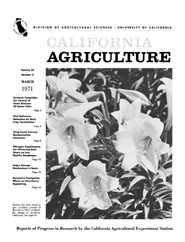


University of California
California Agriculture
|
|||
|
|||

Cover:
Benlate has been found to give excellent control of Botrytis or ‘‘fire” of Easter lily foliage in northwest California.
March 1971
Volume 25, Number 3 News and opinionGeneral Information |
|||
|
University of California, 1301 S. 46th St., Bldg. 478 Richmond, CA
|